Amarok/QuickStartGuide/TheMusicCollection/it: Difference between revisions
Created page with 'Azione' |
Updating to match new version of source page |
||
| (124 intermediate revisions by 2 users not shown) | |||
| Line 1: | Line 1: | ||
<languages /> | <languages /> | ||
=== La collezione musicale === | |||
== | ==== Il riquadro Fonti multimediali ==== | ||
=== | Il riquadro '''Fonti multimediali''' è dove navighi e visualizzi la tua collezione completa di musica. Include le tracce sul tuo disco fisso locale così come quelle su qualsiasi dispositivo o supporto multimediale esterno connesso al tuo computer, come CD audio, lettori multimediali, dischi di rete o fonti internet. | ||
<span id="Setting up a collection"></span> | |||
==== Impostazione di una collezione ==== | |||
<span class="mw-translate-fuzzy"> | |||
Hai tracce audio in formato ''mp3'', ''Ogg'' o ''FLAC'' sul tuo computer? Inizia dicendo ad '''Amarok''' dove trovare questi file così che possa creare la tua collezione. Nel menu in alto: <menuchoice>Impostazioni -> Configura Amarok -> Collezione</menuchoice>. | |||
</span> | |||
= | <span class="mw-translate-fuzzy"> | ||
[[File:Amarok2.4.1ConfigureDialogCollection.png|300px|thumb|center|Finestra di dialogo Configura collezione nella versione 2.5]] | |||
</span> | |||
Viene mostrata una vista ad albero della tua cartella Home. Fai clic sulla casella corrispondente a dove si trova la tua musica, di solito <menuchoice>home -> Musica</menuchoice>. Poi scegli <menuchoice>Scansiona nuovamente l'intera collezione</menuchoice>. Questo richiederà un po' di tempo, dunque non allarmarti se '''Amarok''' sembra lento per un po'. Una volta che la scansione è completa è meglio chiudere '''Amarok''' utilizzando il menu <menuchoice>Amarok</menuchoice> in alto o <keycap>Ctrl + Q</keycap> e quindi riavviarlo. La musica appena aggiunta dovrebbe essere mostrata nella sezione '''Collezione locale'''. | |||
<br /><br /> | |||
Altro riguardo alla configurazione della collezione [[Special:myLanguage/Amarok/Manual/ConfiguringAmarok#Collection|qui]]. | |||
[[ | {{Tip/it|L'insieme di formati multimediali riconosciuti da '''Amarok''' non è ristretto a quelli menzionati sopra; dipende dal backend [[Special:Mylanguage/Phonon|Phonon]].}} | ||
<span id="Adding Media Devices to the Collection"></span> | |||
==== Aggiunta di dispositivi multimediali alla collezione ==== | |||
Sotto alla barra di ricerca vicino alla parte alta del riquadro '''Fonti multimediali''' puoi vedere i differenti dispositivi e/o categorie di contenuto nel '''Navigatore di contesto'''. Se inserisci un CD audio nel lettore, questo apparirà nel riquadro '''Fonti multimediali''' insieme ai lettori multimediali, alle penne USB e ad altri dispositivi USB. Dopo che un dispositivo esterno è stato montato, esso verrà mostrato automaticamente nel riquadro '''Fonti multimediali'''. | |||
Sotto c'è una schermata che mostra tre fonti connesse con musica: CD audio, lettore mp3 e la '''Collezione locale'''. | |||
=== | [[Image:Mediasources.png|250px|thumb|center]] | ||
<span id="Ripping a CD into the collection"></span> | |||
==== Copiare un CD nella collezione ==== | |||
Se non hai alcun file musicale nel tuo computer, è facile copiarlo (copiare le tracce dai tuoi CD alla collezione). Semplicemente inserisci un CD e fai clic destro sul riquadro del dispositivo CD nel '''Navigatore di contenuto''' per riprodurlo o copiarlo nella tua collezione il che significa salvare ed ''etichettare'' le tracce (guarda l'immagine sotto). Se copi musica da un CD audio alla tua '''Collezione locale''', la ''barra dei messaggi'' in basso nella finestra di '''Amarok''' indicherà che la copia è in corso. La copia può richiedere parecchi minuti. Una volta completata il messaggio nella barra dei messaggi scomparirà e la musica comparirà nel navigatore di contenuto della tua '''Collezione locale'''. Se la musica copiata non appare nel riquadro '''Fonti multimediali''', è meglio chiudere '''Amarok''' tramite il menu principale <menuchoice>Amarok</menuchoice> o con <keycap>Ctrl + Q</keycap> e poi riavviarlo. Ora dovresti vederla nella tua collezione. La schermata qui sotto mostra come spostare le tracce dal tuo CD audio, iPod o altro dispositivo nella tua collezione utilizzando il menu contestuale (clic destro). | |||
[[ | [[Image:Amarokripcd.png|250px|thumb|center]] | ||
Nel menu contestuale qui sopra puoi anche vedere la voce <menuchoice>Modifica dettagli della traccia</menuchoice>. Utilizza questa opzione se hai una traccia che necessita di un'etichetta modificata. Questo diventa importante quando salvi musica in formato .WAV, perdendo alcune delle etichette. Se una parte della tua collezione necessita di etichette, considera l'utilizzo di programmi specifici come | |||
* [http://musicbrainz.org/doc/PicardTagger Picard] | * [http://musicbrainz.org/doc/PicardTagger Picard] | ||
* [http://easytag.sourceforge.net EasyTag] | * [http://easytag.sourceforge.net EasyTag] | ||
* [http://kid3.sourceforge.net Kid3] | * [http://kid3.sourceforge.net Kid3] | ||
= | Correggere le etichette è importante per aiutare '''Amarok''' a mostra le tue tracce nei giusti album ed adeguatamente ordinate. Impara di più riguardo la [[Special:mylanguage/Amarok/QuickStartGuide/Glossary#Tags|copia ed assegnazione delle etichette]]. | ||
<span id="Accessing other media sources"></span> | |||
==== Accedere ad altre fonti multimediali ==== | |||
Potresti esserti chiesto perché il riquadro '''Fonti multimediali''' non si chiama riquadro 'Collezioni'. '''Amarok''' ti offre accesso a molta più musica di quella semplicemente presente nella tua collezione: negozi online, audiolibri, podcast, file musicali memorizzati al di fuori della tua collezione e scalette precedentemente memorizzate. La ''navigazione breadcrumb'' di '''Amarok''' è la chiave per tutto ciò. L'icona di partenza per la navigazione breadcrumb è quella della cartella home tutta a sinistra in alto nel riquadro '''Fonti multimediali'''. Questa icona si espande e si contrae mentre sfogli il riquadro '''Fonti multimediali''' permettendoti di accedere facilmente alla tua collezione facendo clic sulla cartella desiderata nella barra breadcrumb. | |||
[[ | [[Image:Amarokbreadcrumb.png|250px|thumb|center]] | ||
Se fai clic sulla cartella home di '''Amarok''' vedrai il riquadro '''Fonti multimediali''' in basso a sinistra contenente le icone delle risorse disponibili. Se fai clic su <menuchoice>File</menuchoice> (immagine sotto a sinistra, secondo elemento dal basso), vedrai qualcosa di simile all'immagine in basso a destra. Nota che ora la barra breadcrumb si espande e che il contenuto della cartella selezionata è mostrato nel riquadro '''Fonti multimediali''' (immagine sotto a destra). Facendo clic sui simboli '''>''' tra gli elementi della breadcrumb puoi visualizzare le cartelle disponibili a quel livello della struttura delle cartelle. Il navigatore di file di '''Amarok''' ti dà accesso all'intero filesystem, anche al di fuori della tua '''Collezione locale'''. | |||
{| class=" | {| class="tablecenter" border=1 | ||
! | ! riquadro Fonti multimediali | ||
! Icona file selezionata | |||
|- | |- | ||
| [[Image:Amarokmediasources-home.png|250px|thumb]] || [[Image:Amarokmediasources-files.png|250px|thumb]] | |||
|} | |} | ||
Le funzioni delle icone nella cartella Home di '''Amarok''' (sopra a sinistra) sono: | |||
{| border=1 | {| border=1 | ||
!Icona | |||
!Nome | |||
!Azione | |||
|- | |- | ||
|[[ | | [[Image:Action-collection-amarok48.png|48px]] || <menuchoice>Musica locale</menuchoice> || La tua collezione di '''Amarok''' | ||
|- | |- | ||
| [[ | | [[Image:Applications-internet.png|48px]] || <menuchoice>Internet</menuchoice> || Negozi online come ''Magnatune'', ''Jamendo'' e ''Last.fm''. Prima configura le risorse internet in: <menuchoice>Impostazioni -> Configura Amarok -> Servizi Internet</menuchoice> | ||
|- | |- | ||
| [[ | | [[Image:View-media-playlist.png]] || <menuchoice>Scalette</menuchoice> || Scalette salvate. Vedi anche [[Special:mylanguage/Amarok/QuickStartGuide/Playlists|Scalette]]. Anche le scalette sui dispositivi multimediali | ||
|- | |- | ||
| [[ | | [[Image:Folder-amarok.png]] || <menuchoice>File</menuchoice> || Il tuo filesystem | ||
|- | |- | ||
| [[ | | [[Image:Hi48-action-podcast-amarok.png]] ||<menuchoice>Podcast</menuchoice> || Accedi ai Podcasts tramite fonti RSS | ||
|} | |} | ||
Facendo clic su <menuchoice>Musica locale</menuchoice> in '''Fonti multimediali''' (immagine sopra) o nella barra breadcrumb ritorni alla tua collezione visualizzando un elenco di tutte le risorse disponibili, artisti, album e tracce che hai precedentemente definito come parti della tua collezione. La barra breadcrumb indica che stai visualizzando la tua ''Musica locale''. | |||
<span id="Streams and Podcasts"></span> | |||
==== Flussi e podcast ==== | |||
Ci sono due modi per ascoltare flussi: | |||
* se hai una stazione preferita, prendi l'URL del flusso ed aggiungilo: <menuchoice>Scaletta -> Aggiungi flusso</menuchoice>. Se poi salvi la tua scaletta, dopo potrai trovarla nuovamente in '''Scalette''' come ''Scaletta salvata''. | |||
* Sfoglia gli script disponibili nel tuo '''Gestore degli script''', <menuchoice>Strumenti -> Gestore degli script</menuchoice> fino a Amarok 2.4.0, dopo la 2.4.1 <menuchoice>Impostazioni -> Configura Amarok -> Script</menuchoice>. Sono disponibili alcune eccellenti collezioni che verranno mostrate nella sezione '''Internet''' del tuo riquadro '''Fonti multimediali'''. | |||
Podcasts have their own section in the '''Media''' pane, above. If you have an RSS or Atom feed URL, click the {{Plus}} and add it there. If you have an OPML file to import, that choice is available also. Use the context (right-click) menus to <menuchoice>Add to playlist</menuchoice>, <menuchoice>Configure</menuchoice>, <menuchoice>Remove Subscription</menuchoice>, <menuchoice>Update Channel</menuchoice>, or mark an episode as <menuchoice>New</menuchoice>. If you are interested in browsing through a large collection of podcasts, check out the '''Podcast Directory''' available through the '''Script Manager''', referred to above. | |||
<br /><br /> | |||
More about configuring '''Amaroks''' '''Internet Services''' [[Special:myLanguage/Amarok/Manual/ConfiguringAmarok#Internet_Services|here]]. | |||
<span id="Using the Content Browser"></span> | |||
==== Utilizzare il Navigatore di contenuto ==== | |||
Il disco fisso del tuo computer, CD audio, dispositivi esterni e Internet sono le risorse di base della tua collezione. Dopo che la collezione è stata configurata, è possibile che contenga un gran numero di album e tracce, molto più di quanto possa essere mostrato in una singola finestra. | |||
=== | Come cambiare la visualizzazione della collezione, sotto: | ||
<span id="Hiding or expanding information"></span> | |||
===== Nascondere o espandere informazioni ===== | |||
L'area del pannello '''Fonti multimediali''' posta sotto la barra di ricerca è definita '''Navigatore di contesto'''. Tre fonti multimediali sono indicate nell'immagine di un '''navigatore di contesto''' con: CD, Collezione locale e Lettore multimediale: | |||
[[Image:CD_Collection_Sansa.png|250px|thumb|center]] | |||
The | Clicking the banner for a device (the blue bar for the Sansa above) shows or hides the content of that device. The direction of the arrow on the right indicates whether the contents for that device is hidden or shown. The content on a particular device can, in turn, be hidden or shown using the same principle, clicking on the appropriate artist or album. An arrow pointing down on the left of an artist or an album indicates that the contents has been expanded. An arrow pointing right indicates that more content for that category is available but currently hidden. In the image above, the information for ''Mike Oldfield - The Songs of Distant Earth'' CD has been expanded, showing the individual tracks. On the other hand, the albums and tracks in the '''Local Collection''' are hidden. By clicking these arrows you also can expand or hide information. | ||
<span id="Changing the order of tracks and albums"></span> | |||
===== Cambiare l'ordine delle tracce e degli album ===== | |||
L'ordine in cui le tracce sono organizzate nel '''Navigatore di contesto''' può essere personalizzato utilizzando il pulsante {{Icon|preferences-other}} posto in cima al pannello '''Fonti multimediali''': | |||
<span class="mw-translate-fuzzy"> | |||
[[File:Amarok2.4CollectionSortingMenu.png|400px|center|thumb|Le opzioni di ordinamento della collezione]] | |||
</span> | |||
The sort order is indicated on the top left of the '''Media Sources''' pane, just below the '''Search''' text box. The default order is '''Artist / Year - Album'''. The display order of the '''Content Browser''' can be temporarily switched between the user-defined sort order (described above) and a ''Merged view'' in which artists are listed alphabetically, no matter on which media the music is stored. To toggle the ''Merged view'', click the {{Icon|view-list-tree}} icon at the top right-hand of the '''Media Sources''' pane: | |||
To search your collection, type your search term into the '''Search bar''' at the top of the '''Local Music''' section. Not only can you search by artist, album or track name, but any part. You might create a nice playlist by searching for '''''winter''''', for instance, or merely find a track when you only remember one word of the title. You can also search by rating, playcount, even filetype. See [[Special:myLanguage/Amarok/Manual/Organization/Collection/SearchInCollection|Search in Collection]] for more details. | |||
<span id="Deleting items from the collection"></span> | |||
===== Eliminazione di elementi dalla collezione===== | |||
<span class="mw-translate-fuzzy"> | |||
Puoi eliminare qualsiasi elemento della collezione facendo clic con il tasto destro e scegliendo l'ultima voce <menuchoice>Elimina tracce</menuchoice>. Apparirà una finestra di conferma per evitare l'eliminazione accidentale di una o più tracce. Per selezionare uno o più elementi utilizza <keycap>Ctrl + click</keycap>. | |||
</span> | |||
| Line 120: | Line 134: | ||
| index=Special:mylanguage/Amarok/QuickStartGuide | indextext=Torna al menu | | index=Special:mylanguage/Amarok/QuickStartGuide | indextext=Torna al menu | ||
}} | }} | ||
<span class="mw-translate-fuzzy"> | |||
[[Category:Amarok/it]] | |||
[[Category:Multimedia/it]] | |||
[[Category:Guide/it]] | |||
</span> | |||
Latest revision as of 17:39, 19 July 2013
La collezione musicale
Il riquadro Fonti multimediali
Il riquadro Fonti multimediali è dove navighi e visualizzi la tua collezione completa di musica. Include le tracce sul tuo disco fisso locale così come quelle su qualsiasi dispositivo o supporto multimediale esterno connesso al tuo computer, come CD audio, lettori multimediali, dischi di rete o fonti internet.
Impostazione di una collezione
Hai tracce audio in formato mp3, Ogg o FLAC sul tuo computer? Inizia dicendo ad Amarok dove trovare questi file così che possa creare la tua collezione. Nel menu in alto: .
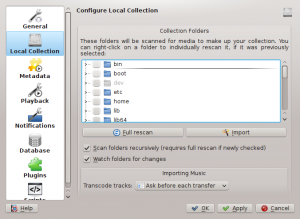
Viene mostrata una vista ad albero della tua cartella Home. Fai clic sulla casella corrispondente a dove si trova la tua musica, di solito . Poi scegli . Questo richiederà un po' di tempo, dunque non allarmarti se Amarok sembra lento per un po'. Una volta che la scansione è completa è meglio chiudere Amarok utilizzando il menu in alto o Ctrl + Q e quindi riavviarlo. La musica appena aggiunta dovrebbe essere mostrata nella sezione Collezione locale.
Altro riguardo alla configurazione della collezione qui.
Aggiunta di dispositivi multimediali alla collezione
Sotto alla barra di ricerca vicino alla parte alta del riquadro Fonti multimediali puoi vedere i differenti dispositivi e/o categorie di contenuto nel Navigatore di contesto. Se inserisci un CD audio nel lettore, questo apparirà nel riquadro Fonti multimediali insieme ai lettori multimediali, alle penne USB e ad altri dispositivi USB. Dopo che un dispositivo esterno è stato montato, esso verrà mostrato automaticamente nel riquadro Fonti multimediali.
Sotto c'è una schermata che mostra tre fonti connesse con musica: CD audio, lettore mp3 e la Collezione locale.
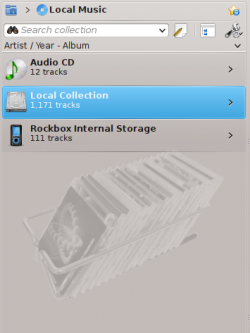
Copiare un CD nella collezione
Se non hai alcun file musicale nel tuo computer, è facile copiarlo (copiare le tracce dai tuoi CD alla collezione). Semplicemente inserisci un CD e fai clic destro sul riquadro del dispositivo CD nel Navigatore di contenuto per riprodurlo o copiarlo nella tua collezione il che significa salvare ed etichettare le tracce (guarda l'immagine sotto). Se copi musica da un CD audio alla tua Collezione locale, la barra dei messaggi in basso nella finestra di Amarok indicherà che la copia è in corso. La copia può richiedere parecchi minuti. Una volta completata il messaggio nella barra dei messaggi scomparirà e la musica comparirà nel navigatore di contenuto della tua Collezione locale. Se la musica copiata non appare nel riquadro Fonti multimediali, è meglio chiudere Amarok tramite il menu principale o con Ctrl + Q e poi riavviarlo. Ora dovresti vederla nella tua collezione. La schermata qui sotto mostra come spostare le tracce dal tuo CD audio, iPod o altro dispositivo nella tua collezione utilizzando il menu contestuale (clic destro).
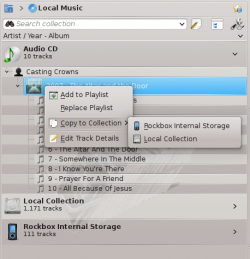
Nel menu contestuale qui sopra puoi anche vedere la voce . Utilizza questa opzione se hai una traccia che necessita di un'etichetta modificata. Questo diventa importante quando salvi musica in formato .WAV, perdendo alcune delle etichette. Se una parte della tua collezione necessita di etichette, considera l'utilizzo di programmi specifici come
Correggere le etichette è importante per aiutare Amarok a mostra le tue tracce nei giusti album ed adeguatamente ordinate. Impara di più riguardo la copia ed assegnazione delle etichette.
Accedere ad altre fonti multimediali
Potresti esserti chiesto perché il riquadro Fonti multimediali non si chiama riquadro 'Collezioni'. Amarok ti offre accesso a molta più musica di quella semplicemente presente nella tua collezione: negozi online, audiolibri, podcast, file musicali memorizzati al di fuori della tua collezione e scalette precedentemente memorizzate. La navigazione breadcrumb di Amarok è la chiave per tutto ciò. L'icona di partenza per la navigazione breadcrumb è quella della cartella home tutta a sinistra in alto nel riquadro Fonti multimediali. Questa icona si espande e si contrae mentre sfogli il riquadro Fonti multimediali permettendoti di accedere facilmente alla tua collezione facendo clic sulla cartella desiderata nella barra breadcrumb.

Se fai clic sulla cartella home di Amarok vedrai il riquadro Fonti multimediali in basso a sinistra contenente le icone delle risorse disponibili. Se fai clic su (immagine sotto a sinistra, secondo elemento dal basso), vedrai qualcosa di simile all'immagine in basso a destra. Nota che ora la barra breadcrumb si espande e che il contenuto della cartella selezionata è mostrato nel riquadro Fonti multimediali (immagine sotto a destra). Facendo clic sui simboli > tra gli elementi della breadcrumb puoi visualizzare le cartelle disponibili a quel livello della struttura delle cartelle. Il navigatore di file di Amarok ti dà accesso all'intero filesystem, anche al di fuori della tua Collezione locale.
| riquadro Fonti multimediali | Icona file selezionata |
|---|---|
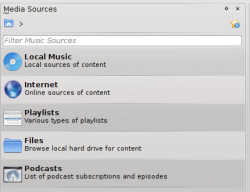 |
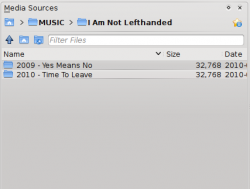 |
Le funzioni delle icone nella cartella Home di Amarok (sopra a sinistra) sono:
| Icona | Nome | Azione |
|---|---|---|
| La tua collezione di Amarok | ||
| Negozi online come Magnatune, Jamendo e Last.fm. Prima configura le risorse internet in: | ||
| Scalette salvate. Vedi anche Scalette. Anche le scalette sui dispositivi multimediali | ||
| Il tuo filesystem | ||
| Accedi ai Podcasts tramite fonti RSS |
Facendo clic su in Fonti multimediali (immagine sopra) o nella barra breadcrumb ritorni alla tua collezione visualizzando un elenco di tutte le risorse disponibili, artisti, album e tracce che hai precedentemente definito come parti della tua collezione. La barra breadcrumb indica che stai visualizzando la tua Musica locale.
Flussi e podcast
Ci sono due modi per ascoltare flussi:
- se hai una stazione preferita, prendi l'URL del flusso ed aggiungilo: . Se poi salvi la tua scaletta, dopo potrai trovarla nuovamente in Scalette come Scaletta salvata.
- Sfoglia gli script disponibili nel tuo Gestore degli script, fino a Amarok 2.4.0, dopo la 2.4.1 . Sono disponibili alcune eccellenti collezioni che verranno mostrate nella sezione Internet del tuo riquadro Fonti multimediali.
Podcasts have their own section in the Media pane, above. If you have an RSS or Atom feed URL, click the ![]() and add it there. If you have an OPML file to import, that choice is available also. Use the context (right-click) menus to , , , , or mark an episode as . If you are interested in browsing through a large collection of podcasts, check out the Podcast Directory available through the Script Manager, referred to above.
and add it there. If you have an OPML file to import, that choice is available also. Use the context (right-click) menus to , , , , or mark an episode as . If you are interested in browsing through a large collection of podcasts, check out the Podcast Directory available through the Script Manager, referred to above.
More about configuring Amaroks Internet Services here.
Il disco fisso del tuo computer, CD audio, dispositivi esterni e Internet sono le risorse di base della tua collezione. Dopo che la collezione è stata configurata, è possibile che contenga un gran numero di album e tracce, molto più di quanto possa essere mostrato in una singola finestra.
Come cambiare la visualizzazione della collezione, sotto:
Nascondere o espandere informazioni
L'area del pannello Fonti multimediali posta sotto la barra di ricerca è definita Navigatore di contesto. Tre fonti multimediali sono indicate nell'immagine di un navigatore di contesto con: CD, Collezione locale e Lettore multimediale:
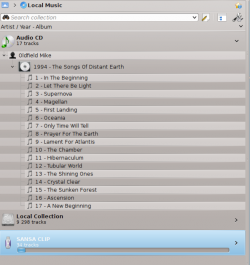
Clicking the banner for a device (the blue bar for the Sansa above) shows or hides the content of that device. The direction of the arrow on the right indicates whether the contents for that device is hidden or shown. The content on a particular device can, in turn, be hidden or shown using the same principle, clicking on the appropriate artist or album. An arrow pointing down on the left of an artist or an album indicates that the contents has been expanded. An arrow pointing right indicates that more content for that category is available but currently hidden. In the image above, the information for Mike Oldfield - The Songs of Distant Earth CD has been expanded, showing the individual tracks. On the other hand, the albums and tracks in the Local Collection are hidden. By clicking these arrows you also can expand or hide information.
Cambiare l'ordine delle tracce e degli album
L'ordine in cui le tracce sono organizzate nel Navigatore di contesto può essere personalizzato utilizzando il pulsante ![]() posto in cima al pannello Fonti multimediali:
posto in cima al pannello Fonti multimediali:
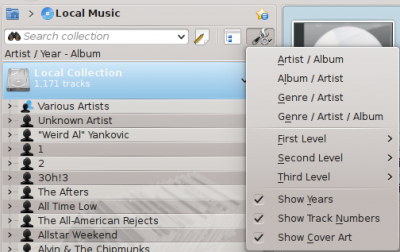
The sort order is indicated on the top left of the Media Sources pane, just below the Search text box. The default order is Artist / Year - Album. The display order of the Content Browser can be temporarily switched between the user-defined sort order (described above) and a Merged view in which artists are listed alphabetically, no matter on which media the music is stored. To toggle the Merged view, click the ![]() icon at the top right-hand of the Media Sources pane:
icon at the top right-hand of the Media Sources pane:
To search your collection, type your search term into the Search bar at the top of the Local Music section. Not only can you search by artist, album or track name, but any part. You might create a nice playlist by searching for winter, for instance, or merely find a track when you only remember one word of the title. You can also search by rating, playcount, even filetype. See Search in Collection for more details.
Eliminazione di elementi dalla collezione
Puoi eliminare qualsiasi elemento della collezione facendo clic con il tasto destro e scegliendo l'ultima voce . Apparirà una finestra di conferma per evitare l'eliminazione accidentale di una o più tracce. Per selezionare uno o più elementi utilizza Ctrl + click.

